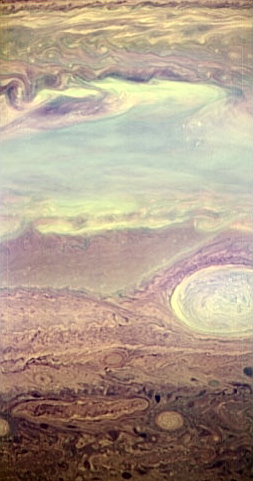Image: NH Jupiter IR (contrast enhanced)
Description: This image, taken with the LEISA infrared camera on the New Horizons Ralph instrument, show fine details in Jupiter's turbulent atmosphere using light that can only be seen using infrared sensors. This is a "false color" picture made by assigning infrared wavelengths to the colors red, green and blue. LEISA (Linear Etalon Imaging Spectral Array) takes images across 250 IR wavelengths in the range from 1.25 to 2.5 microns, allowing scientists to obtain an infrared spectrum at every location on Jupiter. A micron is one millionth of a meter. This picture was taken at 05:58 UT on February 27, 2007, from a distance of 2.9 million kilometers (1.6 million miles). It is centered at 8 degrees south, 32 degrees east in Jupiter "System III" coordinates. The large oval-shaped feature is the well-known Great Red Spot. The resolution of each pixel in this image is about 175 kilometers (110 miles); Jupiter's diameter is approximately 145,000 kilometers (97,000 miles). In this image, red equals 1.28 microns, green equals 1.30 microns and blue equals 1.36 microns, a range of wavelengths that probes different altitudes in the atmosphere. This choice of wavelengths highlights Jupiter's high-altitude south polar hood of haze. This image illustrates only a small fraction of the information contained in a single LEISA scan, highlighting just one aspect of the power of infrared spectra for atmospheric studies.
Title: NH Jupiter IR (contrast enhanced)
Credit: http://photojournal.jpl.nasa.gov/catalog/PIA09255
Author: NASA/Johns Hopkins University Applied Physics Laboratory/Southwest Research Institute
Permission: PD-NASA
Usage Terms: Public domain
License: Public domain
Attribution Required?: No
Image usage
The following 2 pages link to this image:


